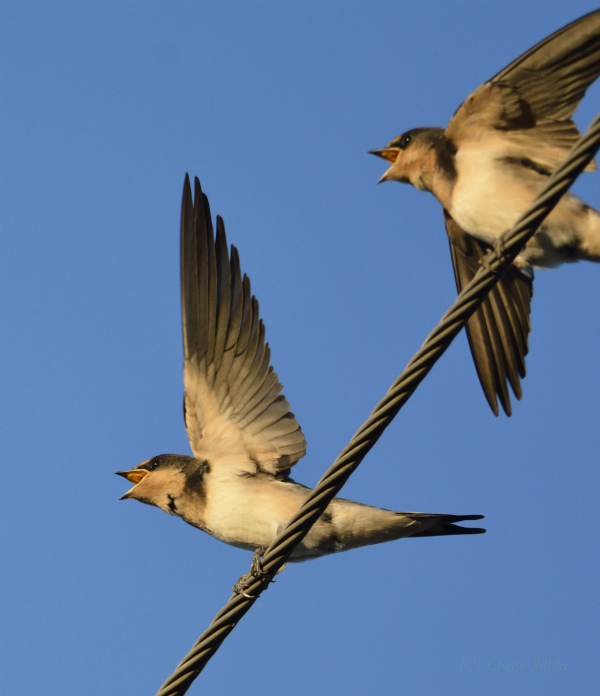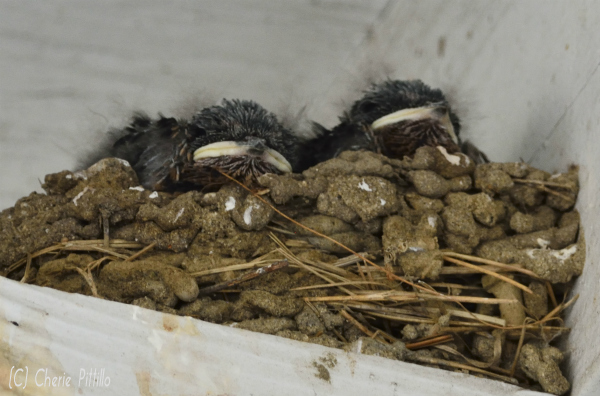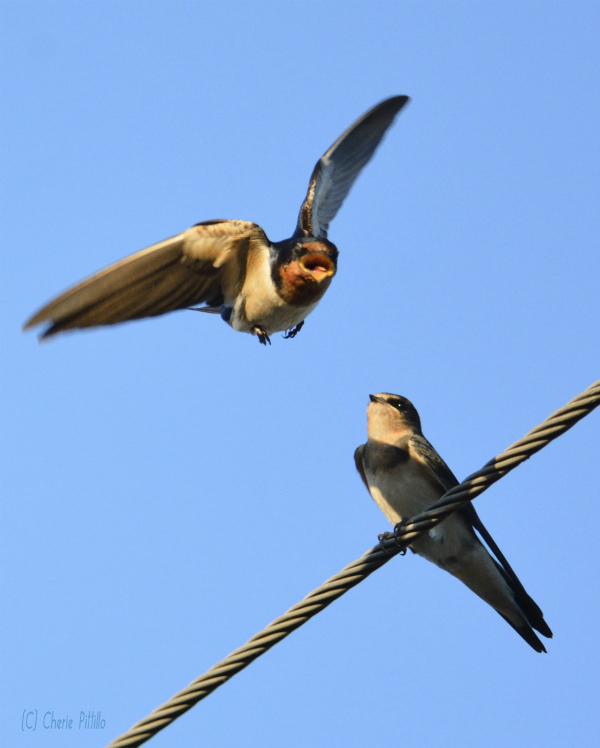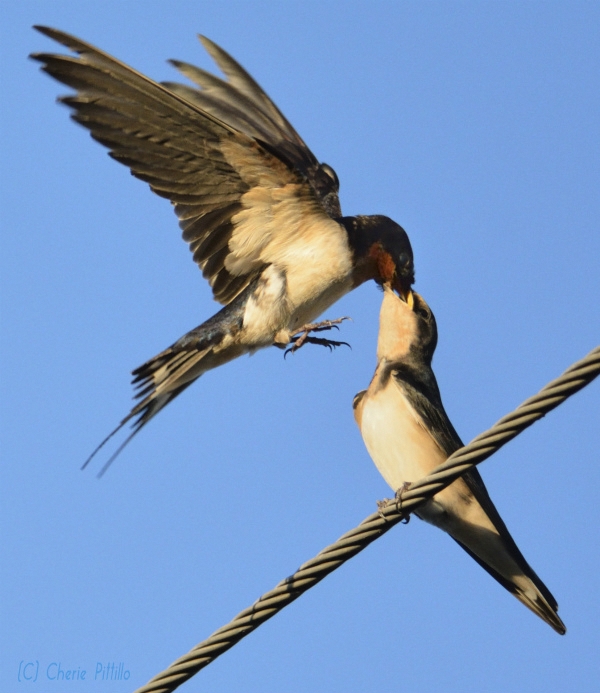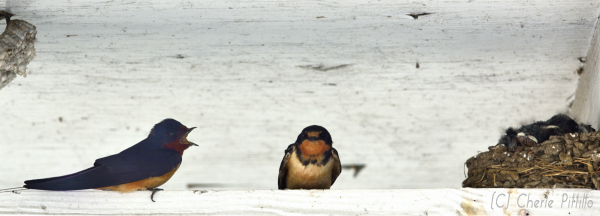Barn Swallow, Hirundo rustica, Golondrina Tijereta (Spanish) Kusam (Mayan)
While watching Barn Swallows gather mud for their mud and grass nests, I observed aggressive behavior several times between two or three birds on a particular spot of damp earth. One swallow would either quickly fly away without any mud or challenge the intruder. Who knew Barn Swallows were mud wrestlers?
How does this big-mouthed bird mix grass and mud together? It seems to grab the grass first and then somehow pack the mud into its mouth to form a pellet. At least that’s what I observed several times.
Both the male and female serve as pellet plasterers to build the nest but the female appears to take control of the shape. Each mud mason makes many mouthfuls to accomplish the nest. In the past Barn Swallows built nests on cliff ledges, rock crevices, or tree holes but now mainly use ledges or edges on buildings in cities, suburbs, farms and under bridges.
That small triangular bill of the Barn Swallow is deceptive because the Barn Swallow sports a huge mouth. Compare the size of the parent’s open mouth with the tiny bill on this fledgling.
Fledglings flutter their wings to beg for food as a parent approaches. I only saw each parent feed one chick at a time. This acrobatic aerialist with Cirque de Soliel maneuvers preys on insects and feeds a pellet of compressed insects to its young. I’ve been buzzed several times as a Barn Swallow swooped by on its insect foray.
So how did this pair become a pair? Size matters. Gulp!
The female selects her mate based on the LENGTH of his two outer tail feathers called streamers. I wonder about her “stream” of consciousness. Those streamers provide the fork of its forked tail, the only swallow in North America with it. In addition she chooses a male with a symmetrical tail and vice versa as a female with a long tail also represent a quality bird. Males with longer tail feathers have a better chance of not only getting a mate but they also get to mate earlier than those with shorter tails. Eggs are laid earlier than those females with shorter-tailed males. Better quality males tend to spend more time with their chicks. And for some reason they have fewer parasites.
Really.
Tail length correlates with
- reproductive success
- annual survival
- ability to withstand parasites
- immunocompetence
- measures of fitness
- and other qualities
Pairs can be monogamous during the breeding season and sometimes in future breeding seasons with the same female and male. They often nest in loose colonies. Sometimes the mated male may mate with another female. But an unmated male may kill one-four day old chicks in the nest to break up the pair to form a new pair bond with the female.
Although similar in color, the adult male chest and underparts vary from dark to lighter cinnamon-colored feathers while females are duller. This species lives throughout the world except in extreme polar regions where it migrates from its breeding range in Northern Hemisphere to overwinter in the Southern Hemisphere. This migrant mainly passes through the Yucatan Peninsula from August-November and March-May.
LINK TO CALL: https://macaulaylibrary.org/audio/106593
In other areas of the world, a Barn Swallow brings good luck if it nests on your property. However, if the nest at a barn is destroyed, the cows may give bloody milk or not produce milk. Another myth states when it stole fire from the gods to share with common people, an angry god threw fire and hit the middle of its tail to leave those two outside tail feathers.
Something that isn’t a myth comes from the respected resource, The Birds of North America online, (BNA). BNA states the slaughter of Barn Swallows to use in the fashion trade inspired George Bird Grinnell (yes, that was his name), to write an editorial in the 1886 magazine, Forest and Stream, to denounce the waste of bird life. That editorial led to the founding of the National Audubon Society.
Maybe the Barn Swallow should be the symbol for this conservation group rather than the “Great Egret”. After all, it’s had a relationship with man-made dwellings and cattle for over 2,000 years. It’s referenced several times in the Bible, in two of Shakespeare’s plays, and in Aristotle’s ethics writings.
SWALLOW YOUR FEAR, SHAKE YOUR TAIL FEATHER TO GET UP, GO OUTSIDE AND EXPLORE NATURE.
DISCLAIMER: References do not agree on details about this species.
http://www.sararegistry.gc.ca/virtual_sara/files/cosewic/sr_barn_swallow_0911_eng.pdf
http://tigerprints.clemson.edu/cgi/viewcontent.cgi?article=2962&context=all_theses
http://bna.birds.cornell.edu/bna/species/452/articles/introduction
http://www.biokids.umich.edu/critters/Hirundo_rustica/#8b0181e9098090f861afd903b86fd198
Sal a Pajarear Yucatan Guia de Aves, A Guide to the Birds of Mexico and Northern Central America, Birds and Reserves of the Yucatan Peninsula, BBC David Attenborough The Life of Birds, Kaufman Lives of North American Birds, Sibley Guide to Bird Live and Behavior
Cherie Pittillo, “nature inspired,” photographer and author, explores nature everywhere she goes. She’s identified 56 bird species in her Merida, Yucatan backyard view. Her column, published on the 7th and 21st of each month, features anecdotes about birding in Merida, Yucatan and beyond. Contact: [email protected] All rights reserved, ©Cherie Pittillo

